The animal kingdom is full of incredible species, and many of them gain independence at an early age as a means of survival, requiring little parental care. In their unique and often dangerous world, there’s little time to waste. These animals can be classified as precocial species, which means they are born in a more advanced state and develop at a rapid pace. These species are typically nidifugous, leaving the nest shortly after being born or hatched. Some physical features include the presence of fur, opened eyes, large brains, etc. They can perform amazing feats early on, such as walking, foraging, swimming, or defending themselves from prey and hunting. Numerous species across the diverse animal kingdom exhibit these unique characteristics. With that in mind, read on to discover 10 animals that are born mature and mobile.
#1: Zebra
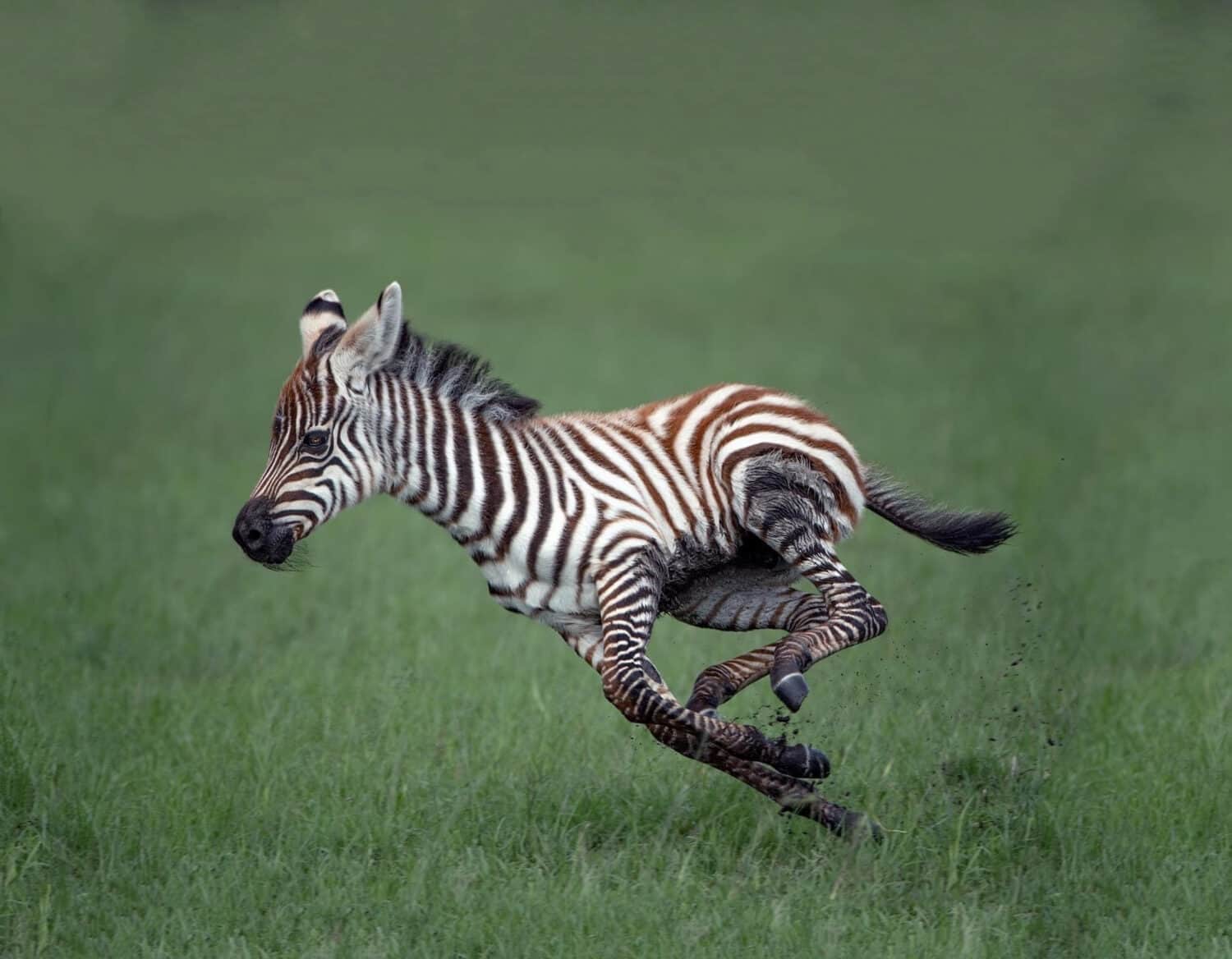
Zebra foals can stand and walk within minutes of their birth.
©Vladimir Turkenich/Shutterstock.com
Known for their striking appearance, zebras (Equus zebra, Equus quagga, Equus grevyi) are the world’s biggest wild horses with distinguished white and black striped patterns. The Plains zebra (Equus quagga) is the most widespread zebra species, roaming the abundant open grasslands of sub-Saharan Africa. They can weigh up to 992 pounds and reach speeds up to 35 miles per hour. It’s impressive that animals this large can be hunted. These heavyweights pack a mighty blow as well. They are known for their devastating kicks, delivering painful or fatal injuries to their natural predators (lions, hyenas, cheetahs, wild dogs, etc.). Prey species are forced to live life on the move, keeping a watchful eye for predators. It’s no surprise that they mature so quickly.
Female zebras’ gestation period can last up to a year, which means their young (foal) are born more advanced. Fashioned with stripes and a mane and weighing up to 77 pounds, foals are easily recognizable from birth. They can begin to engage in playful behavior within hours of birth as well. Some species struggle to move and walk during infancy, but zebra foals can stand up and walk within minutes. Of course, these adaptations are necessary for a species under constant threat. To evade predation, animals of this kind must walk and run independently.
#2: Deer

Fawns go through a “bed phase,” where they can be found alone in a secluded location.
©Steve Byland/Shutterstock.com
One of nature’s most beloved creatures, deer, is typically found roaming the forest, foraging for various crops, vegetation, nuts, acorns, and more. Known as fawns as babies, they are usually weaned by 12 weeks old, but they are active and mature from birth. In fact, they can stand and walk within an hour of being born!
Fawns go through a “bed phase” in the first few days of their lives. That is, their mother (known as a doe) will tuck them away in a secluded location. She will leave them alone and periodically return when it’s time to nurse them. A lone fawn can be a sight to behold, but it can also cause concern among human onlookers. People often confuse this process with abandonment, raising questions as to whether or not they should assist. But this is a natural process that typically doesn’t require human interference. The fawn purposely lays still and is camouflaged to avoid predation. They are capable of fleeing and relocating to a new location, and they will cry to alert and find their mother. Fawns become more active after 30 days and will begin to explore their habitat and feed on food like berries, shrubs, leaves, etc.
#3: Orca

Killer whales are supreme hunters who more than live up to their nickname.
©slowmotiongli/Shutterstock.com
Orca (Orcinus orca) are some of marine life’s most fascinating creatures. Orca are also the largest member of the oceanic dolphin family, but their appearance distinguishes them. They have black bodies with patches near and underneath their eyes. Males can weigh up to an astonishing 10 metric tons (22,000 pounds) and reach lengths of up to 33 feet! In some cases, they can live up to 100 years old. Orcas, also known as killer whales, are found in all oceans and can inhabit cold and tropical waters. Orcas are one of the world’s most formidable predators, hunting everything from walruses, seals, sharks, penguins, and even whales. It’s no wonder they’re known as killer whales.
Killer whales are brilliant and have sophisticated verbal and non-verbal communication skills that aid them while hunting. They are pack hunters that form social units known as pods, developing and coordinating efficient and devastating hunting strategies that can surprise and trap prey. Their powerful teeth (measuring about 3 inches long and around 45 in total) work to tear apart the flesh of their targets. Interestingly, orcas have distinct dialects and can also pass down information from multiple generations — securing the legacy and survival of the pack.
Creatures operating at this level have many responsibilities, so it’s no surprise they mature so early. Females have adapted to these circumstances, with a gestation period of 15-18 months. That means their calves have a significant amount of time to develop and are enormous at birth, weighing up to 365 pounds. These young creatures have many advanced functions, such as swimming immediately at birth. While calves nurse for up to two years, they begin to eat solid food within 12 months. They will take on significant responsibilities as well, helping their mother hunt and being integrated into the social unit. Their mother passes on crucial survival skills in the first year of a calf’s birth, which helps them navigate the social hierarchy, hunt, and learn the pod’s distinct dialects.
#4: Giraffe
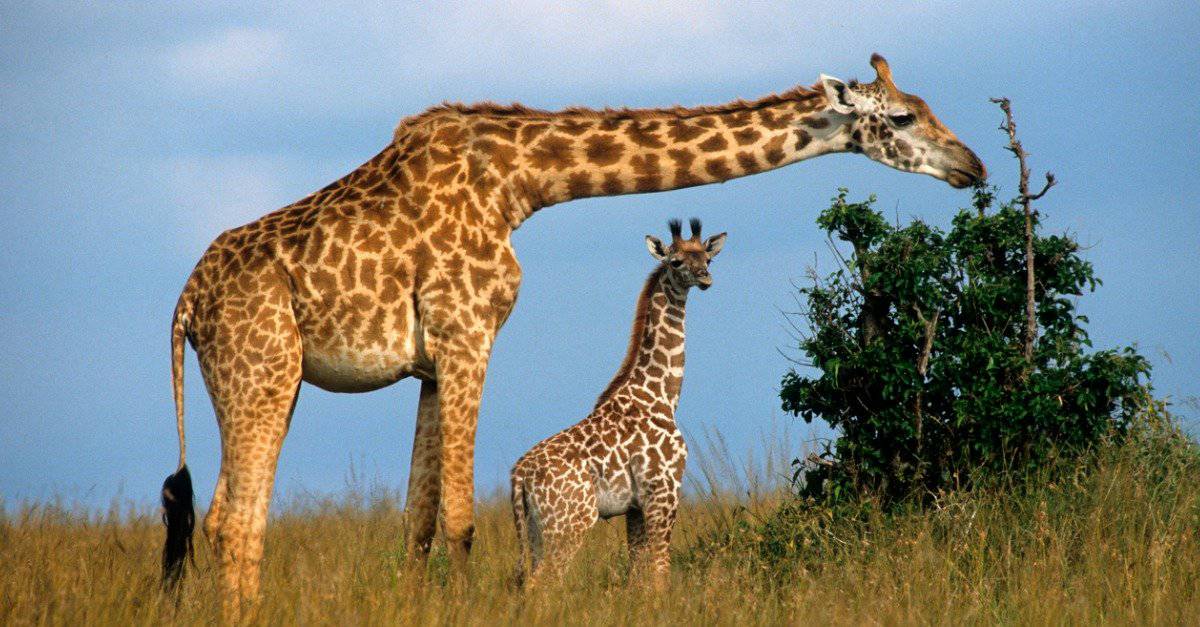
Giraffe calves can weigh up to 220 pounds and reach a shoulder height of up to 5.9 feet at birth.
©iStock.com/Michel VIARD
The giraffe is an iconic animal widely regarded for its majestic and towering presence. Natives of sub-Saharan Africa, this massive species reaches heights up to 20 feet and can weigh up to 4,200 pounds. The giraffe’s height is perfect for foraging for leaves, which they eat upwards of 75 pounds per day. Their size doesn’t slow them down, however, as they can reach impressive speeds of up to 30 miles per hour. Fun fact: giraffes have incredibly long tongues that can grow up to 18 inches long!
The average gestation for females (cows) is 15 months, so their calves are born highly functional. They can stand within minutes, and they begin suckling within an hour. Calves also weigh up to 220 pounds at birth and have a shoulder height of up to 5.9 feet. Their mother will leave them for hours to look for water and forage for food. Calves will remain still on the ground to stay safe from predators. After the first few weeks, they will join other young giraffes in crèches while the mothers continue to leave for long periods. However, mothers will return to nursing and remain with their calves at night. The calves will graduate to juveniles between 9-12 months and gain even more independence. They are entirely independent around the age of two.
#5: Bison

Bison calves begin to join their herd almost immediately after birth.
©Danita Delimont/Shutterstock.com
The largest land mammal in North America, the American bison is a sight to behold. This massive beast can weigh up to an astonishing 2,599 pounds, reaching speeds of up to 40 miles per hour! Bison are herders who typically live in gender-specific herds, with males (bulls) and females (cows) living separately once males leave their mothers — except during mating season. Interestingly, female-led herds generally are larger and are led by a matriarch. The bison diet mainly consists of grass (more than 90%), with shrubs and vegetation included.
The gestation period for these cows lasts for about 285 days, and usually, only one calf is born at a time. Calves weigh between 30 and 70 pounds, and they begin to walk 10 minutes after they’re born. In addition, calves will nurse for up to nine months, though bulls are usually weaned in six months. Coupled with being able to walk minutes after birth, calves can also run and follow their mother and the herd almost immediately.
#6: Hippopotamus
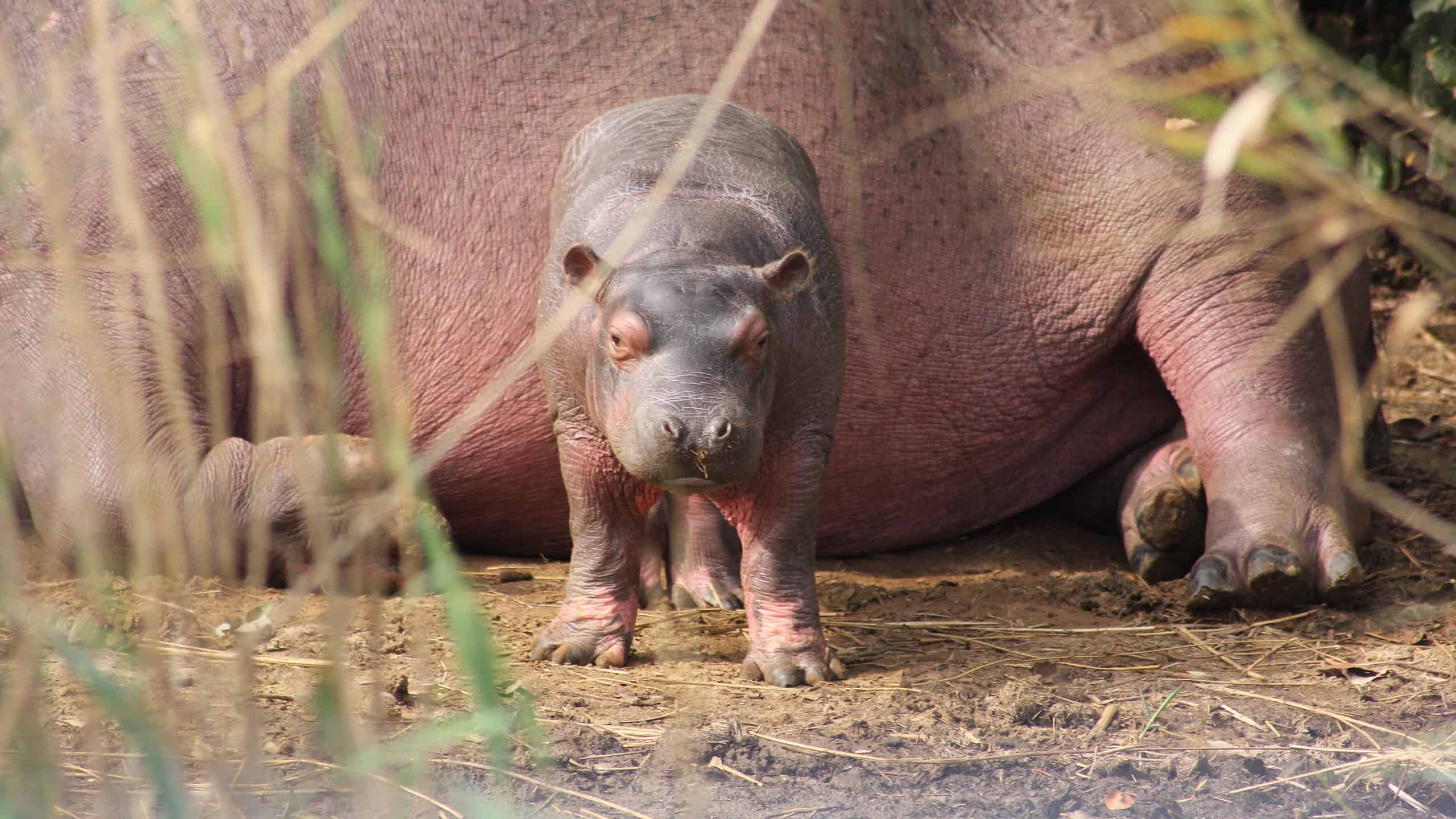
Hippopotamus calves weigh up to 121 pounds at birth!
©Kelly Engelbrecht/Shutterstock.com
The common hippopotamus (Hippopotamus amphibious) is an enormous semi-aquatic mammal native to Africa. Spending much of its time (roughly 18 hours per day) in the water to stay cool, these massive beasts more than earned the title of “river horse.” They typically comprise herds of up to 20, which consists of females and their young. The herd is led by one male who is dominant and protective of the herd’s territory. The hippopotamus is generally known as an aggressive species, ensuring they are difficult to hunt or poach. While it’s surprising that an animal this hefty (2,200-9,900 pounds!) and durable (thick, leathery skin with a barrel-shaped body) can have natural predators, they must look out for threats like lions and alligators, who are more likely to target a calf or a weaker or older adult.
Aggressive prior to giving birth, females leave the herd and will return 10-14 days later once their calf is imprinted on them. Female gestation can last up to 240 days, and they tend to give birth on land or in shallow water. Calves naturally adapt to their environment upon birth. In fact, their ears will naturally fold, and their nostrils will close when they are nursing underwater. Calves begin to graze around one month old, and they are weaned within 6-8 months. They are born weighing between 55-121 pounds.
#7: Sea Turtle

According to scientists, sea turtles will be untraceable for a few years in a period called the “lost years.”
©Julian Wiskemann/Shutterstock.com
Sea turtles are solitary creatures that lead fascinating and challenging lives. They spend most of their lives exploring the world’s oceans, moving at impressive speeds of up to 22 miles per hour. The size of these creatures varies dramatically, between 550-2,000 pounds! They can live up to 80 years old as well. Unfortunately, the life of a sea turtle is filled with turmoil, from dodging predators and polluted water to many other challenges they experience roaming the seas. However, adaptations like a tough shell to avoid predation and a streamlined body with fins allow them to navigate their taxing environment.
Baby sea turtles, or hatchlings, struggle to survive from the beginning. In fact, only one in 1,000 will survive to adulthood. Once their mother nests and lays her eggs, she will return to sea. That means that hatchlings must break out of their shells on their own. They will use a temporary egg tooth called a carbuncle to free themselves from their shell. Buried underground by their mother, hatchlings must dig to the surface once hatched. They will typically wait until nighttime to evade daytime predators.
Once they emerge from their nest on the beach, hatchlings will begin their journey to sea. When they reach the water, they will engage in what’s known as a “swimming frenzy,” which can last up to 48 hours. This helps them reach greater depths in the ocean to stay safe from predators. These fiercely independent creatures then “disappear” for a few years in what scientists call the “lost years.”
#8: Camel

Camels can go an astounding 10 months without water!
©Mrali/Shutterstock.com
Commonly found in hot, dry desert climates in North Africa and the Middle East, camels are one of nature’s most ingenious animals. They have adapted incredibly well to their environment and can go up to 10 months without water! Camels have been trusted by human civilizations for thousands of years, being domesticated as pack animals to carry and transport cargo, as well as mounted for transportation. Camels are herbivores who prefer grass, grains, and salty plants. They store the energy from their food and water as fat in their famous humps. These impressive animals can reach up to 11.5 inches and weigh up to 1,500 pounds.
Camels assemble a herd of up to 40 members, all female and one dominant male. Females have a long gestation period (up to 13 months) and usually give birth to one calf. Calves weigh up to 80 pounds at birth and will begin walking shortly after. They begin to eat independently at one to two months old and are completely weaned at four months old.
#9: Impala
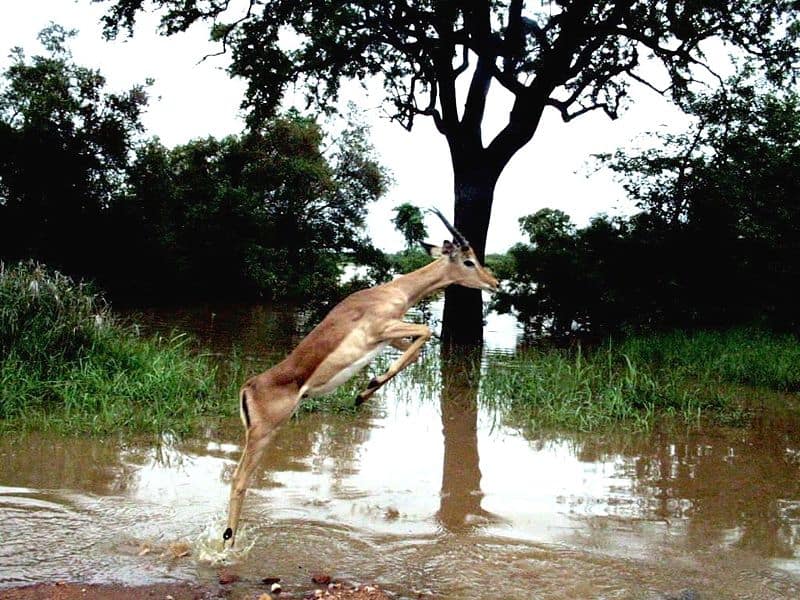
The impala’s reddish-brown fur is an impressive adaptation that keeps them hidden from predators.
©Kyle Meerholz - Public Domain
Native to Africa, the impala is a swift animal that can move up to 50 miles per hour. They have a vegetarian diet, mainly feasting on seeds, flowers, and grass. Impalas have a lean physique, but they weigh between 81 and 165 pounds. Impressively, they can jump up to 10 feet in the air! Impalas assemble in large herds, especially during the rainy season when the weather stimulates abundant growth for grasses, shrubs, and herbs for grazing.
Female impalas tend to give birth during the hottest parts of the day to avoid predators (like lions, cheetahs, and leopards), which prefer to rest and conserve energy around these times. Their reddish-brown fur also helps them stay hidden. Preferring to mate during the rainy seasons, female impalas give birth after a seven-month gestation period. They deliver 11-pound fawns, who are mobile minutes after birth and remain hidden for weeks in a den. Their mother will leave them for hours and return to nurse them. Interestingly, weaned fawns will assemble into a nursery group. After a year of maturing, males leave the group to form a bachelor group. Females will join their mother’s herd.
#10: Capybara
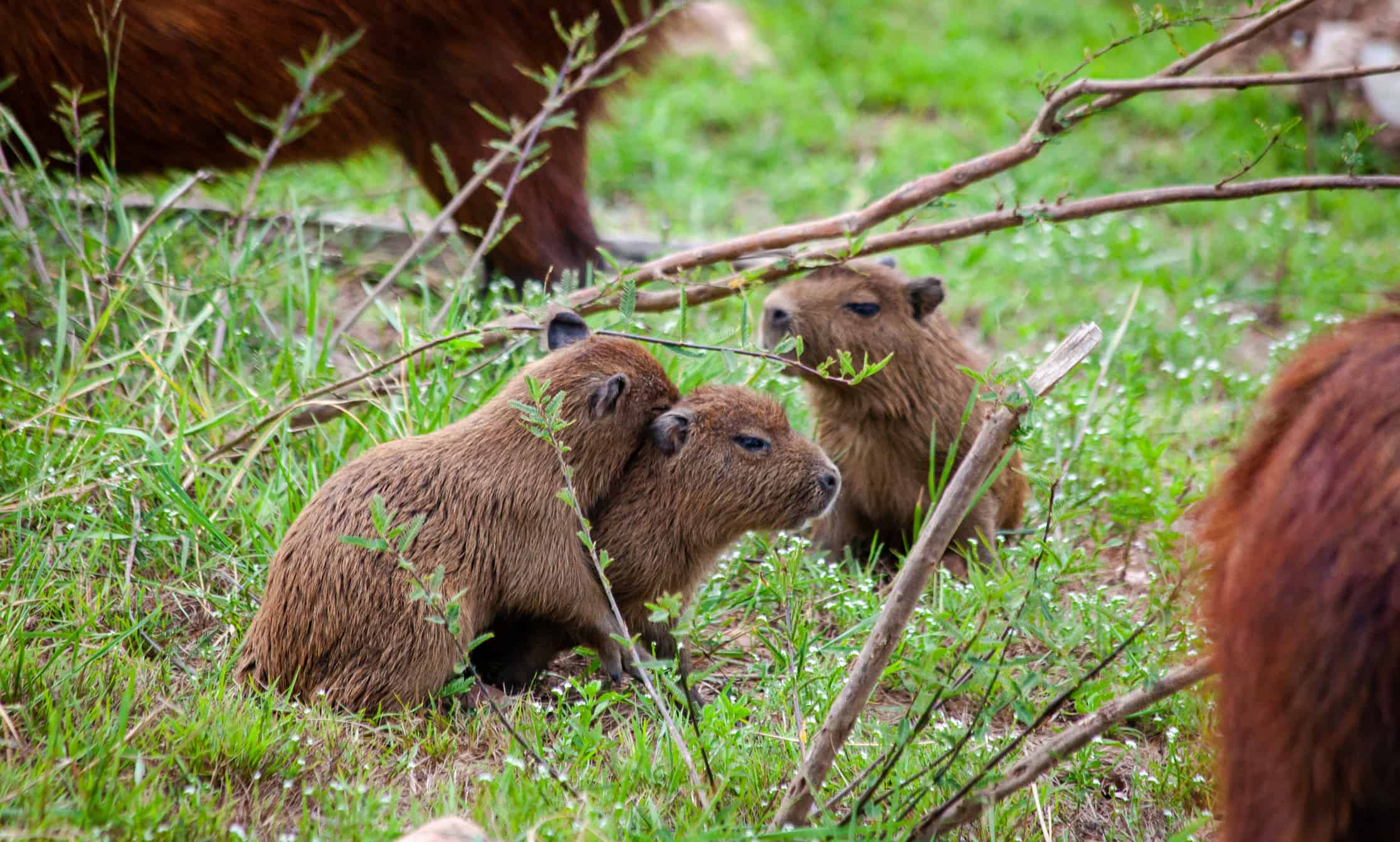
Capybara pups can swim and dive within hours of their birth.
©Manon Le Charpentier/iStock via Getty Images
The capybara or greater capybara (Hydrochoerus hydrochaeris) is a large, semi-aquatic mammal weighing up to 150 pounds. They have webbed feet and hoof-like claws with reddish-brown fur. The greater capybara is the largest living rodent and is found exclusively in South America. They inhabit dense forests close to bodies of water in herds of 10-20, but some groups can be up to 40 members. They live a nocturnal/crepuscular lifestyle, and their natural predators are jaguars, pumas, caiman, and eagles.
Female capybara give birth to 3-pound pups during the rainy season (April and May). Pups are born in a mature state with fur and the ability to see. Additionally, they can walk, swim, and dive within hours of their birth. Capybara pups will join their mother’s herd within a few hours as well. Although not completely weaned, they will begin to eat grass within the first week. They will be fully weaned within four months.
The photo featured at the top of this post is © Mees Kuiper/Shutterstock.com
Thank you for reading! Have some feedback for us? Contact the AZ Animals editorial team.






